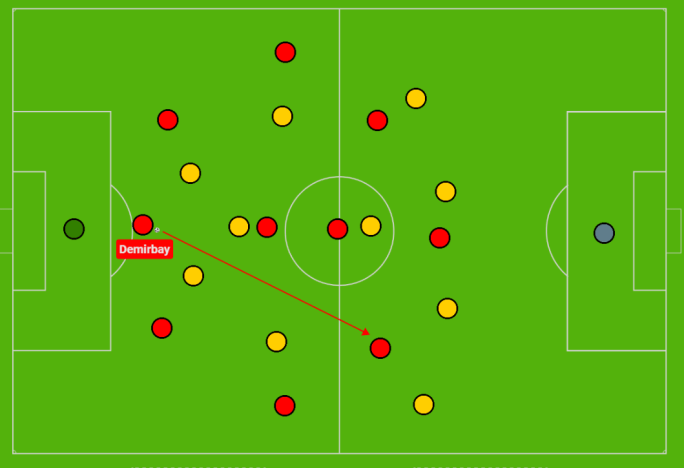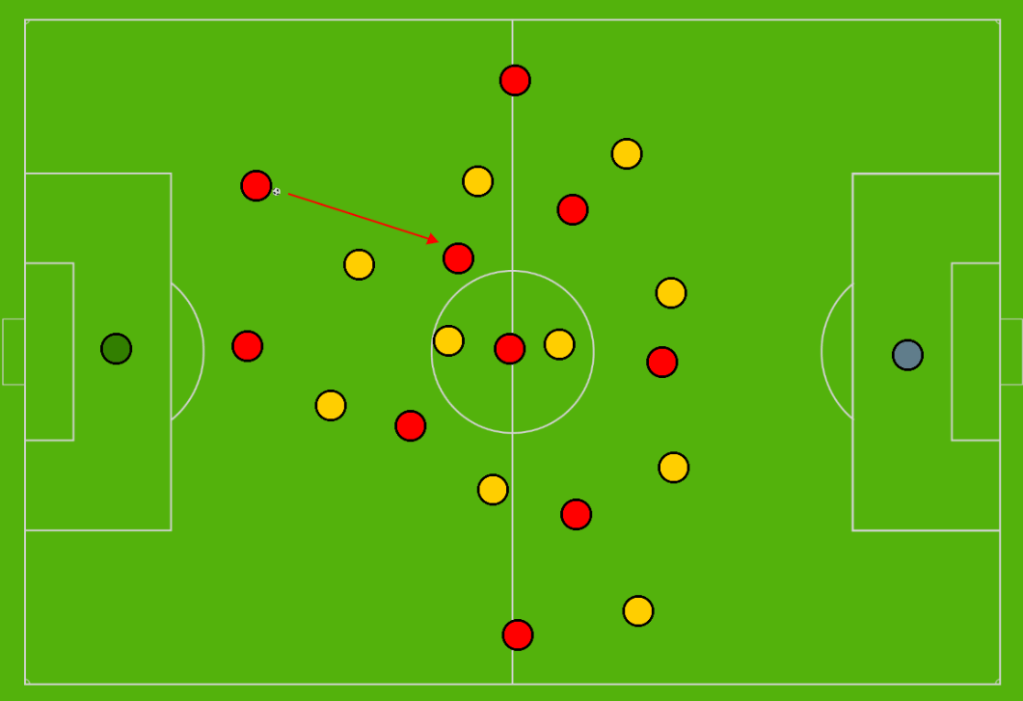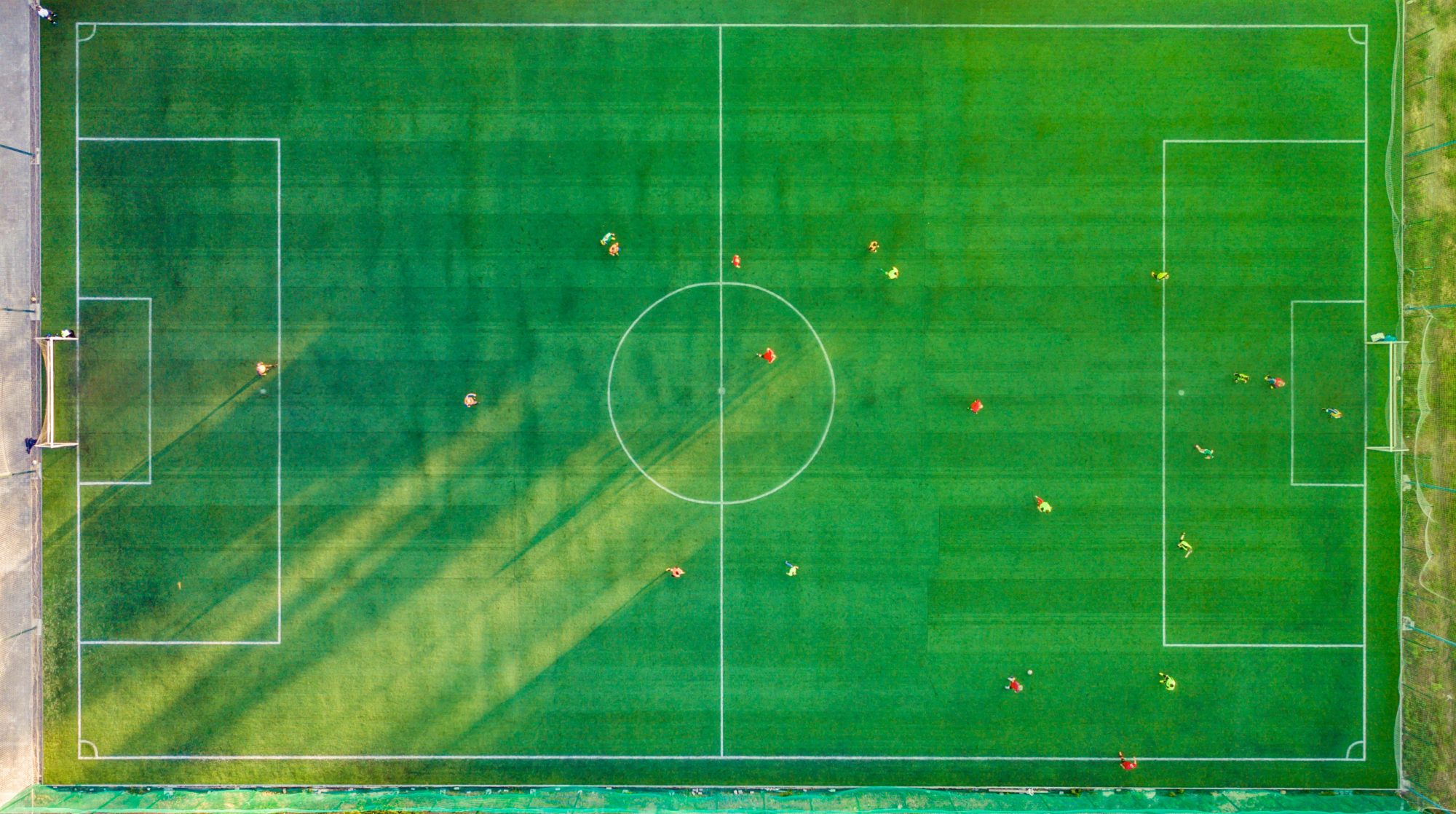In the midst of the massive managerial merry go round of last spring, Gerardo Seoane’s move to Bayer Leverkusen was one of the quieter Bundesliga appointments. But Seoane’s Leverkusen have been louder than most in Germany this season, starting off the 2021-22 campaign in fine form with a UEFA Champions League spot within reach. Along the way, Leverkusen have been playing some exceptional football, with a happy mix of counter-attacking and possession with a purpose. Here is our tactical analysis of Gerardo Seoane’s Bayer Leverkusen in 2021-22.
SYSTEM OF PLAY: 4-2-3-1

Ahead of Seoane’s move to Bayer Leverkusen, we posited that the Swiss manager might deploy the same 4-4-2 formation that he utilized with BSC Young Boys. Instead, Seoane has smartly stuck to what Leverkusen know best, deploying a 4-2-3-1 that works to serve Patrik Schick up top. In fact, two of the three times they’ve moved away from the 4-2-3-1 in the Bundesliga this season, they’ve done so as a response to not having Schick fully fit. Since the side are built around their big man up top, it’s a fairly direct iteration of the 4-2-3-1, with loads of principles centered around quick attacking transitions. But they can also be a possession-based side and work their way up to Schick slowly.
Embed from Getty ImagesAt the very back of Seoane’s system is one of the best goalkeepers in the league – Lukas Hradecky. The Finnish keeper had a fine time at the Euros last summer, and has carried over his form into 2012-22 with an impressive save percentage of 72%. Bayer have a mix of steady experience and youthful verve in front of him, with Jonathan Tah doing well to organize a young back-line in which he, at 25, is the oldest. Mitchell Bakker’s had a fine start to life in Leverkusen to the left of him, with Ecuadorian defender Piero Hincapié also solidly challenging for a place. 20-year-old Odilon Kossounou hasn’t quite hit top gear yet despite featuring in 15 matches so far, and he will continue to learn as he goes along. Significantly more promising, Jeremie Frimpong has made an incredible start to his Bayer career, after arriving from Celtic last season. The Dutch fullback has formed a stellar partnership with Moussa Diaby down the right-hand-side, contributing to 5 goals so far.
Embed from Getty ImagesIn midfield, Seoane has a solid partnership between Exequeil Palacios and Kerem Demirbay brewing into real promise. Charles Aranguiz and Robert Andrich provide two more solid defensive options to play alongside the possession warrior in Demirbay, with Aranguiz more stay at home and Andrich more box to box. Ahead of the midfield two is the other undeniable star in the side, Florian Wirtz, who has dazzled his way toward 5 goals and 8 assists in 15 matches so far. Combine Wirtz’s class and creativity with Moussa Diaby’s incredible pace both on and off the ball, and you get one of the best counter-attacking duos Patrik Schick could dream of having behind him. Diaby’s 5 goals with 6 assists in 15 matches is only bettered by Schick and Wirtz for his team, and no other fullback to wing partnership in the league have hit higher speeds than the Frechman and Frimpong. On the other side, Seoane has more pace and power in Karim Bellarabi, Brazilian speedster Paulinho, and France U21 international Amine Adli. With so much pace and power in behind Patrik Shick, the striker’s job is made all the easier for him. But the Czech forward has been unstoppable all on his own, often making something out of nothing with his chances, and bagging 16 goals in 14 matches so far.
So with that player personnel background in mind, let’s now move on to a discussion about how effective Leverkusen have been in their 4-2-3-1 since Seoane took over.
COUNTER ATTACKING + PACE AND POWER
Embed from Getty ImagesThe first tactical note on Leverkusen, that anyone could notice from a million miles away, is just how deadly they are in attacking transitions. The fantastic stats site WhoScored? lists Leverkusen’s strengths as being – attacking down the wings, counter attacks, creating chances via through balls and finishing scoring chances. These are all words that don’t just describe what Leverkusen excel at, but their over-arching identity under Seoane.
First, when it comes to attacking down the wings, Leverkusen can reach speeds unmatched anywhere else in the league. Frimpong and Bakker both rank inside the top ten fastest players in the league (judged on top speed reached), with Diaby and Bellarabi not too far behind. At times, Diaby’s pace on the break will be so fast that Frimpong and Leverkusen’s left-back simply don’t have time to join the transition. But other times, you’ll be sure to see Frimpong galloping his way on the overlap, and even Bakker underlapping or overlapping his opposite side winger. Quite simply, as he drifts inside on the ball, Diaby’s trickery draws defenders with him, naturally opening up space for Frimpong to seek out space and then deliver into the box on the overlap. While Diaby loves having the ball at his feet, he is well aware of Frimpong’s strengths as well, and has made modifications to his style of play as a result. He’s no longer whipping in crosses like last season, instead becoming a more incisive creator, looking to carry the ball for longer amounts and higher speeds, until he’s able to lightly toe the ball into the penalty area or back out wide for someone else. In fact, he ranks second in the league for both through-balls and carries into the penalty area, and first for nutmegs. All of this combined gives Diaby a frightening dimension to his play, in which Seoane’s men can guide play over to the right first before finding their way to Schick.
Embed from Getty ImagesNext, let’s talk about counter attacking, creating chances via through balls, and finishing their scoring chances. As soon as Leverkusen win the ball, they have three players by which they can immediately find as the first out-ball. More obviously, they can go direct into Schick, allowing him to run the channels or knock it down for someone else. But they can also play into Florian Wirtz, who is intelligent in knowing when to pass versus when to carry the ball. By doing so, they allow greater room for Schick to stretch the opposition defense and occupy attention, as Wirtz and the cast and crew behind can work their magic. Thirdly and perhaps most prominently, they can look to Diaby, whose lightning pace is enough to strike fear into any opposition side. Since they have three excellent options that can each give the team something different in the moment, the variety by which Leverkusen attack is always high, and they don’t have to become overly-reliant on their striker. They can instead simply become reliant on him, constantly feeding him chances to finish off. Many of these chances come on the break via the use of through balls or cut-backs, but Schick can score all kinds of goals, showcased excellently well when he scored from halfway at the Euros.
Embed from Getty ImagesAs the target man that he is, Patrik Schick is also intelligent with his movement in deep, knowing when to play with his back to goal and combine with Florian Wirtz in behind. The quickness of their play can then be aided by the use of Schick to bounce passes back on a one-touch as other players run in behind. In fact, their one-touch mentality is particularly key to the way they excel (and accel.) on the break. It can then also be a detriment to them as they fail to adequately time a pass to match a player’s run. For example, in the 2-2 draw against Koln, Leverkusen were utterly dominant from an attacking perspective and had all of the brighter moments in the match. But they simply couldn’t stay on-side against Koln’s high line, and suffered as a result. But out of all the attacking weaknesses they could have, a slight inability to stay on-side is certainly not the worst. In some ways, it showcases a clear identity Seoane has deployed within the team to play quickly on the break and not waste any time in getting the ball to the team’s danger men.
BUILD-UP

Gerardo Seoane’s team build out from the back via the use of a back-three, with one midfielder (often Kerem Demirbay) dropping into the back-line to pick up possession and spray passes forward. The use of Demirbay in this role can be particularly useful, as he’s typically less safe with his passing than other Leverkusen midfielders, particularly Andrich, who is more of a carrier than elegant passer. Demirbay meanwhile has fantastic range and vision, and often looks to switch play via the use of diagonal long passes from left to right, Leverkusen’s danger side. Only Hradecky has completed more long passes per game than the German’s 4.1, showcasing just how vital he can be in breaking pressure by injecting something different for his team.

Other times, the midfield line will hold a firmly higher position alongside the fullbacks, making the shape look more 2-4-4, which is quite typical of 4-2-3-1 formations. Slightly more unorthodox of 4-2-3-1 formations, Leverkusen’s build-up structures and attack can also become more 2-3-2-3, as someone like Demirbay floats up to join Florian Wirtz in pulling the strings in between the lines. All that said, we are potentially making Gerardo Seoane out to be far less rigid and structured than he actually is. Other than to keep the team’s compactness, his central midfielders don’t venture forward that much, playing a more vital role in defensive transitions than attacking ones. Meanwhile, fullbacks are far more likely to ovlerlap their wing partners than underlap, and while the wingers invert, they don’t tend to go farther than Wirtz as the team’s number ten. So while there’s flexibility and fluidity in their attack and even their build-up, Gerardo Seaone’s team are still very rigid and simplistic, particularly with what they do in longer spells on the ball.
DEFENSIVE PRINCIPLES
Embed from Getty ImagesWhile Leverkusen have scored the third most goals in the Bundesliga this season, no other side in the top half of the table has conceded more. Seoane’s side haven’t been bad defensively, but they also haven’t been brilliant. One potential reason for the higher ratio of goals conceded is that Leverkusen don’t press from the front all that much. They’ve applied less pressure to their opposition than any other Bundesliga team, looking to hold their shape, shuffle with the play, stay compact and trust their ability to eventually win the ball without over-exerting themselves. They save their energy for the attacking side of the game instead, where they tend to excel. This tactic often works. Opposition clubs find it difficult to play vertical passes through the centre of the pitch against Seoane’s side, and struggle to create genuine chances of note. But the amount of time that Leverkusen often spend in their own third, both due to their build-up and due to the opposition’s ability to keep the ball against them, means goals are naturally going to follow. Only Hertha Berlin have spent more time in their defensive third than Seoane’s men, and that’s a problem Seoane will hope to turn around in the new year.

When Gerardo Seoane’s Leverkusen press from the front in a high block, Schick often acts as the first line of pressure. The Czech star can sometimes be joined by the attacking midfielder in a 4-4-2 shape, but more commonly, Leverkusen will deploy more of a 4-4-1-1 or 4-2-3-1 defensive block, aiming to keep their opposition out wide. High up the pitch, Leverkusen’s central midfielders and fullbacks will hold a steady, reserved position, only enacting pressure when the ball enters their zone. Their ball-oriented press remains fairly limited in its intensity otherwise, and Leverkusen will defend most of their games in a mid-block, through their 4-4-1-1 defensive block. While pressing or counter-pressing don’t seem to be major focuses of Seoane, the Swiss manager isn’t slow to make changes when he sees players not giving their maximum defensive effort. Against Dortmund, we noted Paulinho’s lack of willingness to press and track Meunier down Bayer’s left, and the Brazilian has since made way for Bellarabi and Adli.
Embed from Getty ImagesBut still, Leverkusen could collectively step up their intensity off the ball. Through allowing their opposition to have the ball, Leverkusen allow incisive passes to be played in between the gaps of their fullbacks and centre-backs more than they’d like. The centre-backs may then be drawn out of position to pressure, leaving more space for opposition strikers to score. This is where Odilon Kossounou has struggled in particular, as he doesn’t quite have the experience yet to know exactly where to position himself in relation to his fellow fullback friend. The team’s poor marking and awareness from open play can sometimes extend to set-pieces, where they’ve conceded 7 goals this season. So if there is one area of the game in which Gerardo Seoane should look to improve his side come the new year, it undoubtedly will be their defensive play. Leverkusen haven’t been all that terrible defensively, but you definitely expect more from a manager who focused so heavily on pressing with BSC Young Boys.
CONCLUSION
Embed from Getty ImagesGerardo Seoane has built a formidable Bayer Leverkusen side, that score goals for fun through quick and intense counter attacking moves. Seoane has found a way to get the best out of all of his team’s star players, building his team around the star of all at the top of the Christmas tree in Patrik Schick. Leverkusen will need to drastically improve their defensive side of the game if they are to truly challenge for a top four place in 2021-22, but for now, their impressive 40 goal tally has them firmly in fourth, with no sign of slowing down.
So there it is! A tactical analysis of Gerardo Seoane’s Bayer Leverkusen. Be sure to check out more of our Bundesliga analyses, and follow on social media via the links below. Thanks for reading and see you soon.
How I created a football tactics empire
In 2016, I started TheMastermindSite.com as a passion project, writing about whatever interested me at the time. Five hundred articles and five years of coaching experience later, I had created one of the biggest platforms in the tactics/analysis space, certainly by a sole proprietor. Now going on 1,200 articles, I deep-dive into how I created…
Game of Numbers #37 – Forge FC’s use of centre-backs in midfield like Manchester City
For the unfamiliar, Forge FC are the Manchester City of the Canadian Premier League. They play a possession-based 4-3-3, stacked with ball-savvy savants, and a culture that embodies winning. The Canadian Premier League’s been around since 2019 now. Forge have won the Playoffs in four of the five seasons, and lost the final in the…
Enzo Maresca – Leicester City – Tactical Analysis
It has been a season to remember for Leicester City inside the Championship. They’ve been one of the league’s all-time top sides, and look fully prepared to hit the mark if they can keep hold of their star power leading into next season. Enzo Maresca and his team have done a brilliant job in assembling…
Why centre-backs are becoming fullbacks: The tactical trend that defined 2023
It might be wrong to credit this tactical approach to Pep Guardiola. After all, the origin story to the ‘fullback’ is because the defender was fully back. However, in operating with a centre-back that steps up into midfield, Guardiola also created a construction within his team that regularly positioned centre-backs out wide. From then on,…






11 thoughts on “Gerardo Seoane – Bayer Leverkusen – Tactical Analysis”